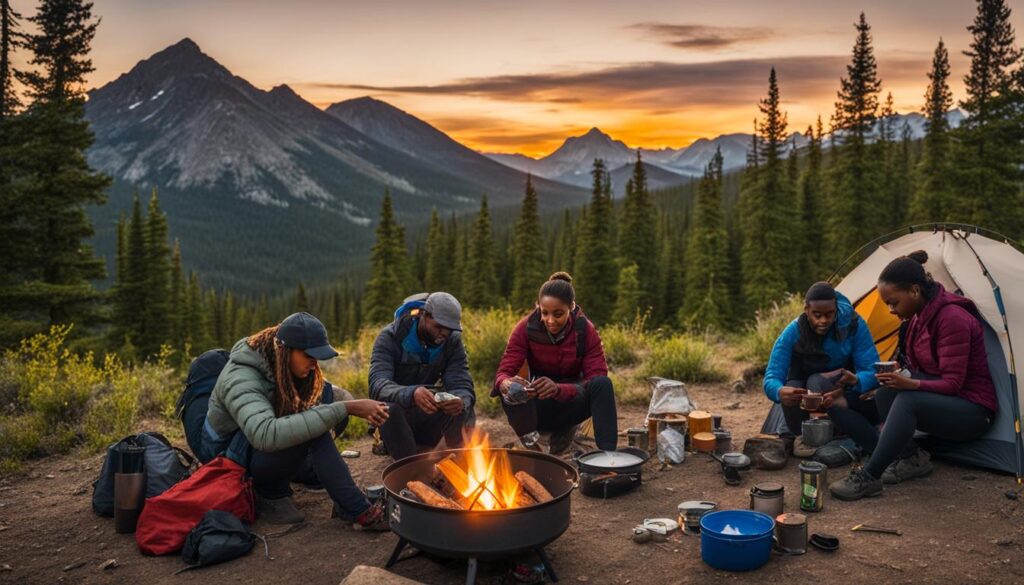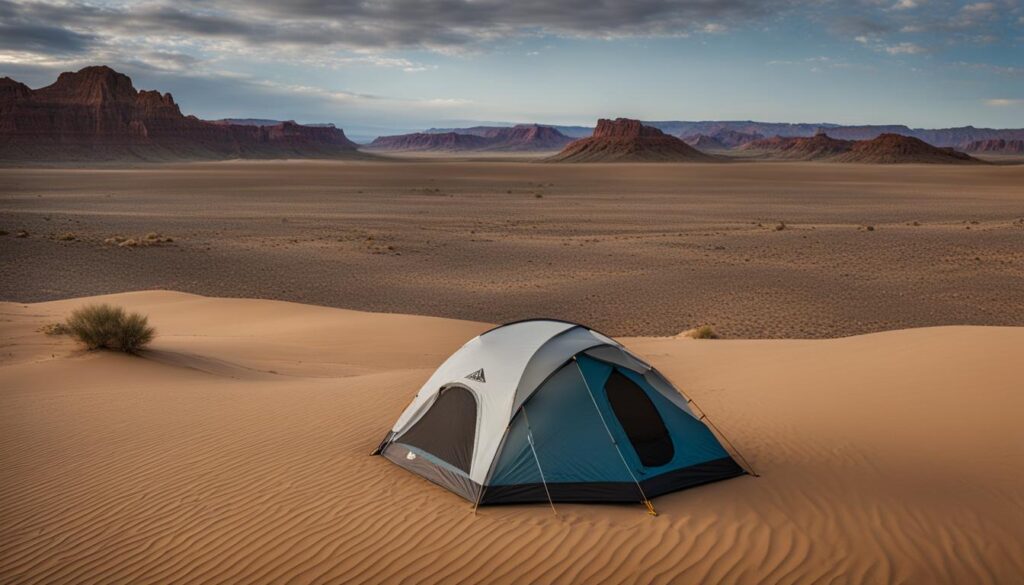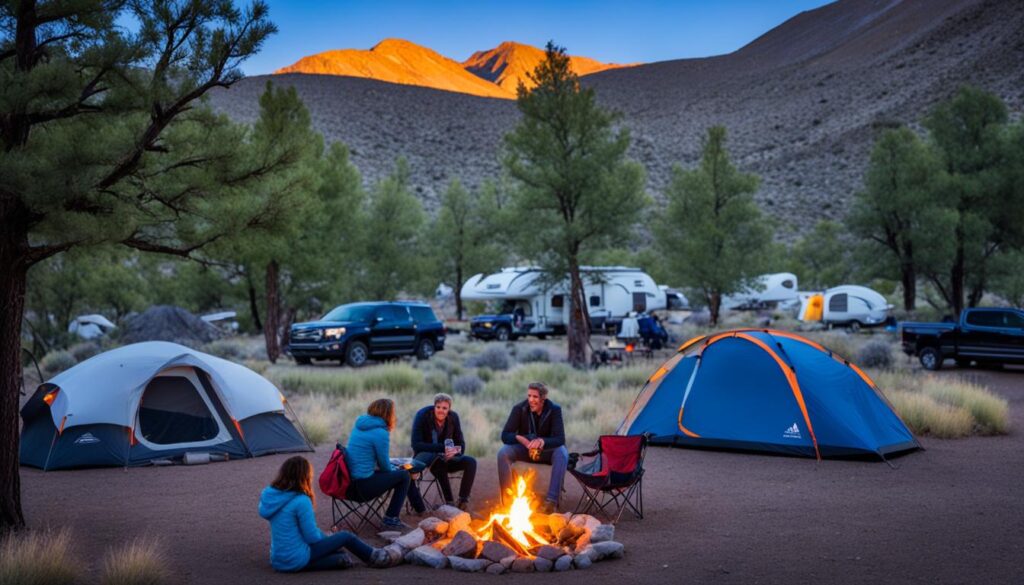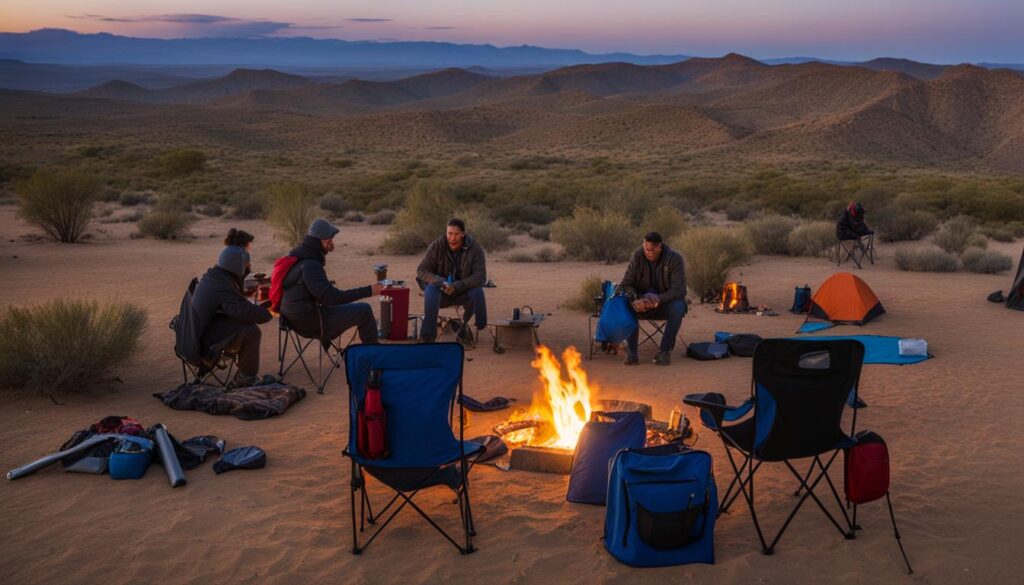When it comes to camping, there are countless opportunities to immerse oneself in nature and enjoy the tranquility of the great outdoors. One such option is BLM camping, which refers to camping on lands managed by the Bureau of Land Management (BLM). But what exactly is BLM camping, and what can you expect from this unique experience?
BLM-managed lands encompass a vast expanse of diverse landscapes, from deserts to forests, offering a wide range of camping options for outdoor enthusiasts. These options include developed campgrounds, dispersed camping, and backcountry camping. Each choice provides its own set of advantages and considerations, allowing campers to tailor their experience to their preferences.
Whether you prefer the convenience of a developed campground with amenities like restrooms and picnic areas, or the solitude and seclusion of dispersed camping in remote areas, BLM camping has something to offer for everyone. However, it’s important to familiarize yourself with the specific regulations, permits, fees, and limitations that apply to each location to ensure a safe and enjoyable camping trip.
So, if you’re eager to venture into the wilderness, explore breathtaking landscapes, and reconnect with nature, BLM camping might be the perfect choice for your next outdoor adventure. Let’s delve deeper into the various aspects of BLM camping and discover the beauty and serenity that await.
Key Takeaways:
- BLM camping refers to camping on lands managed by the Bureau of Land Management.
- BLM-managed lands offer a wide range of camping options, including developed campgrounds, dispersed camping, and backcountry camping.
- Developed campgrounds provide amenities such as restrooms and picnic areas, while dispersed camping offers a more remote experience.
- Permits, fees, and limitations vary by location, so it’s important to research and comply with the regulations specific to each site.
- BLM camping allows individuals to immerse themselves in nature and enjoy the solitude and beauty of the great outdoors.
Contents
Developed Campgrounds
When it comes to BLM camping, developed campgrounds provide a convenient option for those seeking essential amenities and facilities. These campgrounds are equipped with features such as restrooms, water, and electrical hookups to enhance the camping experience. Some developed campgrounds even offer additional amenities like picnic areas and tent pads, allowing campers to enjoy their surroundings comfortably.
It’s important to note that amenities can vary from one campground to another. To ensure you have the most accurate and up-to-date information, it’s advisable to check the specific campground’s website or contact the BLM field office responsible for managing the area. They will be able to provide detailed insights about the facilities available and any regulations or guidelines you need to be aware of.
Most BLM campgrounds require campers to pay a fee, which helps support the maintenance and upkeep of the facilities. Fees may vary depending on the location and the services provided. Additionally, campsite selection in developed campgrounds is typically on a first come, first serve basis. Arriving early can increase your chances of securing a preferred campsite.
For a comprehensive overview of developed campgrounds, including their locations, amenities, and any specific regulations or rules, refer to the BLM’s website or contact the nearest BLM office.

Benefits of Developed Campgrounds
“Developed campgrounds are ideal for campers looking to enjoy a rustic outdoor experience while still having access to essential facilities and amenities. These campgrounds offer a balance between comfort and immersion in nature.”
| Pros | Cons |
|---|---|
| Convenient amenities like restrooms, water, and electrical hookups | Availability may be limited during peak seasons |
| Picnic areas and tent pads for added comfort | May require a fee for camping |
| Accessible locations near popular outdoor destinations | Campsite selection usually on a first come, first serve basis |
| Opportunity to connect with fellow campers and share experiences | Amenities may vary from campground to campground |
Permits, Fees, and Limitations
When planning your BLM camping trip, it’s important to be aware of the permits, fees, and limitations that may apply. These rules help ensure a safe and enjoyable experience for all campers.
Most BLM campgrounds require a fee, which goes towards maintaining the facilities and providing essential services. The fees can vary depending on the location and the amenities offered. It’s a small price to pay for the convenience and comfort of developed campgrounds.

Some campgrounds also allow reservations through recreation.gov. This can be particularly useful if you’re planning your camping trip during peak season or if you prefer to have a guaranteed spot.
Camping stay limits also vary by location, but they usually range around two weeks within a month period. This ensures that more people have the opportunity to enjoy the campgrounds and prevents any single individual or group from monopolizing them.
Upon arrival at the campground, campers are generally required to pay the camp fees. This can be done at a self-registration station or by contacting the campground host or staff. It’s important to have the necessary funds ready to avoid any inconvenience.
Additionally, it’s crucial to not leave personal property unattended for more than a specified time. This is to prevent any unattended belongings from being a hazard or causing inconvenience to other campers.
Lastly, adverse weather conditions may affect campground availability, so it’s essential to check for seasonal closures before your trip. This will ensure that you have accurate information and can plan your camping adventure accordingly.
Camping Permit and Fee Table
| BLM Campground | Permit Required | Fee |
|---|---|---|
| Glenwood Springs Campground, Colorado | No | $15 per night |
| Moab BLM Campgrounds, Utah | No | $20 per night |
| Red Rock Canyon National Conservation Area, Nevada | No | $20 per night |
| Mule Canyon Campground, Utah | Yes | $10 per night |
| Pahranagat National Wildlife Refuge, Nevada | Yes | $5 per vehicle per day |
Disclaimer: The above table provides a general overview of camping permits and fees at selected BLM campgrounds. It’s important to visit the specific campground’s website or contact the corresponding BLM field office for accurate and up-to-date information regarding permits and fees.
Dispersed Camping
Dispersed camping provides outdoor enthusiasts the opportunity to immerse themselves in nature by camping in areas away from developed recreation facilities. Unlike developed campgrounds, dispersed camping allows for a more remote and secluded experience. This type of camping is permitted on most public lands, including those managed by the Bureau of Land Management (BLM), as long as it does not conflict with other authorized uses or pose a threat to wildlife or natural resources.
One of the main benefits of dispersed camping is the opportunity for solitude and a closer connection to nature. Campers can choose their own camping locations and enjoy the peace and tranquility of the great outdoors. By venturing away from crowded campgrounds, individuals have a greater chance of experiencing untouched landscapes and wildlife encounters.
Rules and regulations regarding dispersed camping may vary by BLM office, but there are some general guidelines that campers should follow. It is important to use existing camping sites whenever possible, as they have been established to minimize environmental impact. Creating new disturbances by clearing vegetation or digging trenches is discouraged to preserve the natural integrity of the area.
Furthermore, dispersed camping is typically limited to a specific duration, often around 14 days within a 28-day period, to prevent long-term occupation of a particular area. These limitations help ensure that multiple individuals can enjoy the beauty of public lands throughout the year.
Benefits of Dispersed Camping
The benefits of dispersed camping are numerous, making it an appealing option for outdoor enthusiasts. Here are some advantages:
- Seclusion: Dispersed camping provides a greater level of privacy and allows campers to escape the hustle and bustle of popular campgrounds.
- Closer to Nature: By camping in remote locations, individuals can fully immerse themselves in the natural environment and enjoy the sights and sounds of wildlife.
- Flexibility: Unlike developed campgrounds with limited availability, dispersed camping allows campers to choose their own camping locations based on personal preferences.
- Cost Savings: Dispersed camping is often free or comes at a significantly lower cost compared to staying at developed campgrounds. This makes it a budget-friendly option for camping enthusiasts.
Overall, dispersed camping offers a unique and rewarding camping experience for those seeking solitude, immersion in nature, and flexibility in choosing their camping locations. By abiding by the rules and guidelines set by the governing authorities, campers can enjoy the beauty of public lands while minimizing their environmental impact.

| Benefits of Dispersed Camping | |
|---|---|
| Seclusion | Escape the crowds of developed campgrounds |
| Closer to Nature | Immerse yourself in the natural environment |
| Flexibility | Choose your own camping locations |
| Cost Savings | Free or lower cost compared to developed campgrounds |
Campsite Selection
When it comes to camping on BLM-managed lands, campsite selection plays a crucial role in ensuring a memorable and enjoyable outdoor experience. It’s important to choose your campsite wisely, considering factors such as accessibility, safety, and impact on the environment.
Here are some tips for finding the perfect campsite on BLM lands:
- Secondary Roads: Dispersed camp sites are commonly found along secondary roads. These are often gravel or dirt roads that branch off from main highways. Be prepared for rougher terrain and make sure your vehicle is suitable for the conditions.
- Unmarked Sites: Unlike developed campgrounds, dispersed campsites may not be marked or designated. Look for areas with flat disturbed ground that indicate previous campers have used the spot.
- Popular Locations: Well-known camping spots on BLM lands are often recognizable by the presence of multiple flat areas that have been used as camp sites in the past. These areas have already been impacted and are suitable for use.
It’s essential to use existing campsites rather than creating new ones. Creating new disturbances can harm the natural environment and disrupt ecosystems. By utilizing existing sites, you help minimize your impact and preserve the beauty of the surrounding area.
Remember to practice proper disposal of refuse and leave no trace. Pack out what you pack in to keep the campsite clean and prevent pollution. By respecting the environment and adhering to Leave No Trace principles, we can ensure the preservation of these beautiful landscapes for future generations.
Additional State Requirements
While camping on BLM lands generally follows a set of federal regulations, it’s important to be aware that specific states may have additional requirements or restrictions for dispersed camping. Some states may enforce camping permits, limit the duration of stays, or have specific rules regarding the use of campfires and pets.
Before embarking on your camping trip, make sure to research and understand the BLM camping regulations specific to the state you’ll be visiting. You can find this information on state park websites or by contacting the nearest BLM office or information center.
Exploring the various campsite options on BLM lands offers the opportunity to immerse yourself in nature and create lasting memories. By following responsible camping practices and respecting the regulations in place, you can enjoy the beauty and tranquility of the great outdoors while leaving the land unspoiled for others to appreciate.
Definitions and Clarifications
When it comes to exploring the great outdoors, understanding the ins and outs of BLM camping is essential. Public lands managed by the government, including national parks, state and city parks, and national forests, provide opportunities for outdoor enthusiasts to enjoy nature’s wonders. The Bureau of Land Management (BLM) is a branch of the U.S. Department of the Interior responsible for managing public lands for multiple uses.
BLM camping encompasses two main types: developed campgrounds and dispersed camping. Developed campgrounds offer facilities like restrooms, water, and electrical hookups, making them suitable for those seeking a more structured camping experience. These campgrounds often require fees and reservations. On the other hand, dispersed camping allows campers to set up their tents away from designated areas, giving them the opportunity to embrace a more remote camping experience.
Dispersed camping is primarily allowed in most public lands, as long as it doesn’t cause harm to wildlife or natural resources. It provides campers with a chance to connect closely with nature and enjoy the solitude and tranquility of the great outdoors. The regulations and limitations for both developed campgrounds and dispersed camping may vary depending on the specific location, so it’s always important to be aware of the rules and guidelines before embarking on a camping trip.
By familiarizing yourself with the definitions and clarifications of BLM camping, you can make more informed decisions when planning your outdoor adventures. Whether you prefer the convenience of developed campgrounds or the freedom of dispersed camping, the beauty of public lands awaits.
Finding BLM Land
When planning a camping trip on BLM-managed lands, finding the perfect location is essential. Fortunately, there are several resources available to help you locate BLM camping areas.
BLM Website
The Bureau of Land Management has an interactive web map on their website that allows you to explore BLM-managed lands across the United States. You can easily search for camping locations based on the area you are interested in. This can provide you with a list of available BLM camping areas near your preferred destination.
Physical Maps
If you prefer a more tangible resource, you can obtain physical BLM maps from BLM offices or print them online. These maps provide detailed information about specific BLM land locations and their boundaries, helping you plan your camping trip more effectively.
Contacting BLM Offices
If you have specific questions or need additional information about BLM camping locations, contacting the closest BLM office or information center is a great option. The knowledgeable staff can provide insights, updated information on closures, regulations, and weather conditions in the area you plan to visit.
Using these resources will ensure you can easily locate the ideal BLM camping location for your outdoor adventure.
“Exploring different BLM camping locations allows you to discover the diverse beauty of our public lands.” – Anonymous
Benefits of Outdoor Recreation
When it comes to outdoor recreation, camping on public lands, such as those managed by the Bureau of Land Management (BLM), offers a host of benefits. One of the primary advantages is the opportunity to connect with nature. Escaping the hustle and bustle of everyday life allows you to immerse yourself in the peaceful and rejuvenating natural environment.
Packing the right essentials is crucial for a successful camping trip. Ensuring you have the necessary items, such as tents, sleeping gear, food, water, and safety equipment, will help you fully enjoy your outdoor experience on public lands. By bringing along these essentials, you can rest assured that you are prepared for any situation that may arise.
Engaging in outdoor recreation and camping also contributes to an improved quality of life. Spending time in nature has been proven to reduce stress, enhance mental well-being, and promote physical health. It provides an opportunity to unplug from technology and embrace the simplicity and tranquility of the natural world.
Moreover, by supporting outdoor recreation and camping on public lands, you are also contributing to the local economy. These activities generate revenue for nearby communities through tourism, job creation, and increased consumer spending. Additionally, volunteering on public lands allows individuals to give back and play an active role in preserving these precious spaces for future generations.
FAQ
What is BLM camping?
BLM camping refers to camping on lands managed by the Bureau of Land Management (BLM), which is a branch of the U.S. Department of the Interior responsible for managing public lands for multiple uses.
What are some tips for camping in developed campgrounds?
When camping in developed campgrounds, it’s important to familiarize yourself with the specific regulations and rules of the campground. Make sure to bring all necessary camping supplies and amenities may vary, so it’s essential to check the specific campground’s website or contact the field office.
Do I need a permit to camp on BLM land?
The need for permits to camp on BLM land depends on the specific location and activity. Some areas may require a permit, while others may not. It’s best to check with the local BLM office or information center for the specific regulations and permit requirements.
What are the limitations on camping on BLM land?
Camping limitations on BLM land vary by location but are usually around two weeks within a month period. However, it’s important to note that rules may vary, so it’s best to check with the local BLM office or information center for the specific camping limitations.
What is dispersed camping?
Dispersed camping refers to camping in areas away from developed recreation facilities. It allows individuals to camp in more remote locations and offers the benefit of solitude and a closer connection to nature.
How do I select a campsite on BLM land?
When selecting a campsite on BLM land, it’s important to follow the guidelines provided by the specific BLM office or information center. It’s also helpful to use maps and online resources to locate designated camping areas and to contact the closest BLM office for updated information on closures, regulations, and weather conditions.
What does BLM stand for?
BLM stands for Bureau of Land Management.
How can I find BLM land for camping?
To find BLM land for camping, you can use the interactive web map provided on the BLM website. Physical maps can also be obtained from BLM offices or printed online. Additionally, contacting the closest BLM office or information center can provide further insights and updated information on closures, regulations, and weather conditions.
What are the benefits of outdoor recreation on public lands?
Outdoor recreation on public lands offers numerous benefits, including connecting with nature, improving quality of life, and supporting the economy. Camping allows individuals to disconnect from technology and enjoy the natural environment. Additionally, volunteering on public lands can provide opportunities to give back and contribute to the preservation of these spaces.






